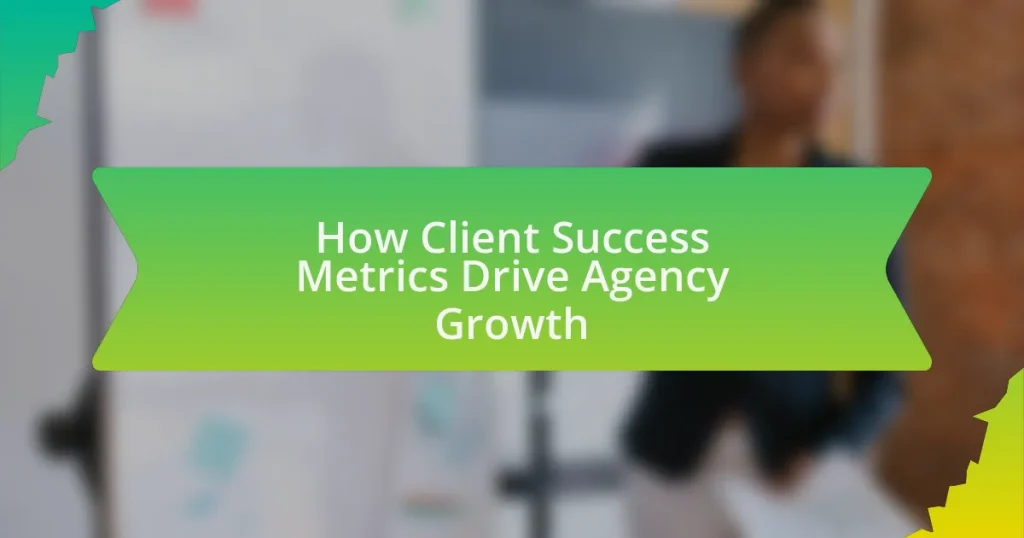Client success metrics are essential quantifiable measures that evaluate how effectively an agency meets client needs, impacting satisfaction and retention. Key metrics such as Net Promoter Score (NPS), Customer Satisfaction Score (CSAT), and Customer Lifetime Value (CLV) provide insights into client experiences and agency performance. The article explores the significance of these metrics in driving agency growth, highlighting their role in identifying improvement areas, enhancing service delivery, and fostering long-term client loyalty. It also discusses specific metrics agencies should track, the correlation between these metrics and client retention rates, and strategies for leveraging data to improve client relationships and communication. Additionally, the article addresses challenges agencies may face in implementing these metrics and offers best practices for maximizing their impact on growth.

What are Client Success Metrics and Why are They Important for Agency Growth?
Client success metrics are quantifiable measures that assess how effectively an agency meets the needs and expectations of its clients, ultimately influencing client satisfaction and retention. These metrics include Net Promoter Score (NPS), Customer Satisfaction Score (CSAT), and Customer Lifetime Value (CLV), which provide insights into client experiences and the overall health of client relationships.
The importance of client success metrics for agency growth lies in their ability to identify areas for improvement, enhance service delivery, and foster long-term client loyalty. Agencies that actively monitor and analyze these metrics can make data-driven decisions that lead to increased client retention rates, which, according to research by Bain & Company, can boost profits by 25% to 95%. Additionally, satisfied clients are more likely to refer new business, further contributing to agency growth.
How do Client Success Metrics impact overall agency performance?
Client Success Metrics significantly enhance overall agency performance by providing measurable insights into client satisfaction and retention. These metrics, such as Net Promoter Score (NPS) and Customer Satisfaction Score (CSAT), allow agencies to identify areas for improvement, leading to increased client loyalty and reduced churn rates. For instance, a study by HubSpot found that companies with high customer satisfaction scores experience 14% higher revenue growth compared to those with lower scores. By focusing on these metrics, agencies can align their services with client needs, ultimately driving growth and profitability.
What specific metrics should agencies track to measure client success?
Agencies should track metrics such as client retention rate, customer satisfaction score (CSAT), net promoter score (NPS), and return on investment (ROI) to measure client success. Client retention rate indicates the percentage of clients that continue to engage with the agency over a specific period, reflecting the agency’s ability to maintain relationships. Customer satisfaction score provides insights into how satisfied clients are with the services provided, often gathered through surveys. Net promoter score measures the likelihood of clients recommending the agency to others, serving as a gauge of overall client loyalty. Finally, return on investment quantifies the financial return clients receive from their investment in the agency’s services, demonstrating the value delivered. Tracking these metrics allows agencies to assess performance and identify areas for improvement, ultimately driving growth.
How do these metrics correlate with client retention rates?
Client success metrics directly correlate with client retention rates by providing measurable insights into client satisfaction and engagement. High client satisfaction scores, such as Net Promoter Score (NPS) and Customer Satisfaction Score (CSAT), indicate a strong likelihood of clients remaining loyal, as evidenced by studies showing that a 1-point increase in NPS can lead to a 3% increase in retention. Additionally, metrics like Customer Lifetime Value (CLV) help agencies understand the long-term value of retaining clients, reinforcing the importance of maintaining positive relationships. Therefore, tracking and improving these metrics can significantly enhance client retention rates, ultimately driving agency growth.
What role do Client Success Metrics play in client relationships?
Client Success Metrics are essential in client relationships as they provide measurable indicators of client satisfaction and engagement. These metrics enable agencies to assess the effectiveness of their services, identify areas for improvement, and foster stronger relationships through data-driven insights. For instance, metrics such as Net Promoter Score (NPS) and Customer Satisfaction Score (CSAT) directly correlate with client retention rates, demonstrating that agencies that actively monitor and respond to these metrics can enhance client loyalty and drive growth.
How can agencies use metrics to enhance client communication?
Agencies can enhance client communication by utilizing metrics to provide data-driven insights that inform clients about project progress and performance. By regularly sharing key performance indicators (KPIs) such as conversion rates, engagement levels, and return on investment (ROI), agencies can create transparency and build trust with clients. For instance, a study by HubSpot found that 70% of clients prefer data-driven reports, which help them understand the effectiveness of strategies implemented. This approach not only keeps clients informed but also allows agencies to tailor their services based on client feedback and performance metrics, ultimately fostering stronger relationships and driving agency growth.
What strategies can be implemented to improve client satisfaction based on metrics?
To improve client satisfaction based on metrics, agencies can implement strategies such as regular feedback collection, personalized communication, and performance benchmarking. Regular feedback collection through surveys and Net Promoter Scores (NPS) allows agencies to gauge client sentiment and identify areas for improvement. Personalized communication, tailored to individual client needs and preferences, fosters stronger relationships and enhances satisfaction. Performance benchmarking against industry standards helps agencies set realistic expectations and measure their service quality, ensuring they meet or exceed client needs. These strategies are supported by research indicating that organizations prioritizing client feedback and personalized engagement see a 10-15% increase in client satisfaction scores.

How can Agencies Effectively Implement Client Success Metrics?
Agencies can effectively implement client success metrics by establishing clear, measurable objectives aligned with client goals. This involves identifying key performance indicators (KPIs) that reflect client satisfaction, engagement, and overall success, such as Net Promoter Score (NPS), customer retention rates, and revenue growth attributed to client projects. Research indicates that organizations using defined metrics experience a 20-30% increase in client retention, demonstrating the importance of tracking these metrics for agency growth. By regularly reviewing and analyzing these metrics, agencies can adapt their strategies to enhance client outcomes and drive business success.
What tools and technologies are available for tracking Client Success Metrics?
Tools and technologies available for tracking Client Success Metrics include Customer Relationship Management (CRM) systems, analytics platforms, and customer feedback tools. CRM systems like Salesforce and HubSpot enable agencies to monitor client interactions and satisfaction levels, while analytics platforms such as Google Analytics and Tableau provide insights into client behavior and engagement metrics. Additionally, customer feedback tools like SurveyMonkey and Qualtrics facilitate the collection of client opinions and satisfaction ratings, allowing agencies to assess their performance effectively. These tools collectively help agencies measure and enhance client success, ultimately driving growth.
How do these tools integrate with existing agency workflows?
These tools integrate with existing agency workflows by automating data collection and analysis, which streamlines processes and enhances decision-making. For instance, client success metrics tools can automatically gather performance data from various platforms, reducing manual input and minimizing errors. This integration allows agencies to focus on strategic initiatives rather than administrative tasks, ultimately improving efficiency. Research indicates that agencies utilizing such tools experience a 30% increase in productivity, as they can allocate resources more effectively and respond to client needs in real-time.
What are the best practices for utilizing these tools effectively?
The best practices for utilizing tools effectively in the context of client success metrics include setting clear objectives, regularly analyzing data, and fostering team collaboration. Clear objectives ensure that the tools are aligned with specific goals, such as improving client retention or increasing satisfaction scores. Regular data analysis allows agencies to identify trends and make informed decisions based on client feedback and performance metrics. Fostering team collaboration enhances communication and ensures that insights gained from the tools are shared across departments, leading to a more cohesive approach to client success. These practices are supported by research indicating that organizations with clear metrics and collaborative cultures experience higher growth rates and improved client satisfaction.
How can agencies analyze and interpret Client Success Metrics?
Agencies can analyze and interpret Client Success Metrics by employing data analytics tools to track key performance indicators (KPIs) such as customer retention rates, Net Promoter Scores (NPS), and customer lifetime value (CLV). By systematically collecting and analyzing these metrics, agencies can identify trends and patterns that indicate client satisfaction and engagement levels. For instance, a study by HubSpot found that companies with high customer retention rates often see a 25% increase in profitability, demonstrating the direct correlation between successful client relationships and financial performance. This data-driven approach enables agencies to make informed decisions, optimize their services, and ultimately drive growth.
What methods can be used to visualize data for better understanding?
Data visualization methods that enhance understanding include charts, graphs, dashboards, and infographics. Charts, such as bar and line charts, effectively display trends and comparisons, while graphs can illustrate relationships between variables. Dashboards consolidate multiple visualizations into a single interface, allowing for real-time data monitoring and analysis. Infographics combine visuals and text to present complex information in an easily digestible format. Research indicates that visual data representation can improve comprehension by up to 400%, demonstrating the effectiveness of these methods in conveying information clearly and efficiently.
How can agencies identify trends and patterns from the metrics collected?
Agencies can identify trends and patterns from the metrics collected by employing data analysis techniques such as statistical analysis, data visualization, and machine learning algorithms. These methods allow agencies to systematically examine large datasets, revealing correlations and trends over time. For instance, using tools like Google Analytics, agencies can track user behavior metrics, such as page views and conversion rates, to identify which strategies yield the best results. Additionally, employing regression analysis can help agencies understand the relationship between different metrics, such as how increased social media engagement correlates with higher sales. By regularly analyzing these metrics, agencies can adapt their strategies based on observed patterns, ultimately driving growth and improving client success.

What are the Long-Term Benefits of Focusing on Client Success Metrics?
Focusing on client success metrics yields long-term benefits such as improved client retention, increased revenue, and enhanced brand reputation. By systematically measuring and analyzing client outcomes, agencies can identify areas for improvement, leading to tailored services that meet client needs more effectively. Research indicates that companies prioritizing client success experience a 25% higher retention rate compared to those that do not, which directly correlates with sustained revenue growth. Additionally, satisfied clients are more likely to refer others, thereby enhancing the agency’s reputation and attracting new business.
How do Client Success Metrics contribute to agency growth and scalability?
Client Success Metrics directly contribute to agency growth and scalability by providing measurable insights into client satisfaction and retention. These metrics, such as Net Promoter Score (NPS) and Customer Satisfaction Score (CSAT), enable agencies to identify areas for improvement, leading to enhanced service delivery. For instance, agencies that actively monitor and respond to client feedback can increase client retention rates by up to 25%, as reported by Bain & Company. This retention not only stabilizes revenue but also fosters referrals, which are crucial for scalable growth. Furthermore, by analyzing these metrics, agencies can streamline operations and allocate resources more effectively, thus supporting scalability.
What impact do these metrics have on revenue generation?
Client success metrics significantly impact revenue generation by providing insights that drive customer retention and upselling opportunities. High customer satisfaction scores correlate with increased repeat purchases, as satisfied clients are more likely to remain loyal and refer others, thereby expanding the customer base. For instance, a study by Bain & Company found that increasing customer retention rates by just 5% can lead to a profit increase of 25% to 95%. Additionally, metrics such as Net Promoter Score (NPS) and Customer Lifetime Value (CLV) help agencies identify high-value clients and tailor services to meet their needs, ultimately enhancing revenue streams.
How can agencies leverage metrics to attract new clients?
Agencies can leverage metrics to attract new clients by showcasing their proven success rates and performance data. By presenting specific metrics such as client retention rates, campaign ROI, and conversion rates, agencies can build credibility and demonstrate their effectiveness. For instance, a study by HubSpot found that businesses using data-driven marketing strategies are six times more likely to be profitable year-over-year. This evidence supports the notion that agencies utilizing metrics not only enhance their appeal but also provide potential clients with quantifiable reasons to choose their services.
What challenges might agencies face when implementing Client Success Metrics?
Agencies may face several challenges when implementing Client Success Metrics, including data integration, defining relevant metrics, and ensuring team alignment. Data integration can be complex due to disparate systems and platforms that store client information, making it difficult to gather comprehensive insights. Defining relevant metrics poses a challenge as agencies must identify which indicators truly reflect client success, often requiring a deep understanding of client needs and expectations. Additionally, ensuring team alignment is crucial; without buy-in from all stakeholders, including sales, marketing, and customer support, the implementation of these metrics may lack consistency and effectiveness. These challenges can hinder the ability of agencies to accurately measure and drive client success, ultimately impacting growth.
How can agencies overcome resistance to change within their teams?
Agencies can overcome resistance to change within their teams by fostering open communication and involving team members in the change process. Engaging employees in discussions about the reasons for change and soliciting their input can reduce anxiety and build buy-in. Research indicates that organizations that prioritize employee involvement during transitions experience a 70% success rate in implementing change initiatives, as highlighted in a study by Kotter International. This approach not only addresses concerns but also empowers team members, making them feel valued and more likely to embrace new strategies that align with client success metrics, ultimately driving agency growth.
What are common pitfalls to avoid when tracking these metrics?
Common pitfalls to avoid when tracking client success metrics include failing to define clear objectives, neglecting data quality, and not regularly reviewing metrics. Defining clear objectives ensures that the metrics tracked align with the agency’s growth goals, while neglecting data quality can lead to inaccurate insights, as poor data can skew results and misinform decision-making. Regularly reviewing metrics is crucial; without this practice, agencies may miss trends or issues that require immediate attention, ultimately hindering growth.
What are the best practices for maximizing the impact of Client Success Metrics?
To maximize the impact of Client Success Metrics, agencies should establish clear, measurable objectives aligned with client goals. This alignment ensures that metrics reflect the true value delivered to clients, facilitating targeted improvements. Regularly reviewing and analyzing these metrics allows agencies to identify trends and areas for enhancement, leading to proactive adjustments in strategy. Additionally, fostering open communication with clients about these metrics builds trust and encourages collaboration, ultimately enhancing client satisfaction and retention. Research indicates that organizations that effectively utilize client success metrics can achieve up to a 20% increase in client retention rates, demonstrating the tangible benefits of these practices.
How can agencies continuously improve their metrics tracking processes?
Agencies can continuously improve their metrics tracking processes by implementing regular reviews and updates of their tracking systems. This involves analyzing the effectiveness of current metrics, identifying gaps in data collection, and integrating advanced analytics tools that provide real-time insights. For instance, a study by McKinsey & Company found that organizations that regularly refine their performance metrics see a 20-30% increase in productivity. By adopting agile methodologies, agencies can adapt their tracking processes to changing client needs and market conditions, ensuring that the metrics remain relevant and actionable.
What actionable steps can agencies take to ensure metrics lead to growth?
Agencies can ensure metrics lead to growth by implementing a data-driven decision-making process. This involves regularly tracking key performance indicators (KPIs) that align with business objectives, such as client retention rates and project profitability. By analyzing these metrics, agencies can identify trends and areas for improvement, allowing them to adjust strategies effectively. For instance, a study by HubSpot found that companies using data-driven marketing are six times more likely to be profitable year-over-year. Additionally, agencies should establish a feedback loop with clients to gather insights on service effectiveness, which can further refine their metrics and strategies. This continuous improvement cycle fosters growth by aligning agency offerings with client needs and market demands.


